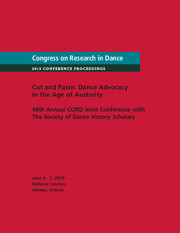Article contents
Dancing National Ideologies: The Athens Festival in the Cold War
Published online by Cambridge University Press: 02 August 2016
Abstract
The international Athens Festival was prominent in shaping a cosmopolitan identity and openness within Greek society. During its first decade (1955–1966), the Festival also functioned as a significant form of cultural diplomacy. Audiences were exposed to elite dance companies from nations such as the U.S., which functioned ideologically and diplomatically. Our presentation interrogates the construction of a dance field in Greece and the shaping of aesthetic values, contextualized within socio-cultural tensions. Research exposes imperatives of a rising superpower consolidating its position, revealing multiple types of influence on Greece and other nations in a battle of political wills with the USSR.
- Type
- Research Article
- Information
- Copyright
- Copyright © Stacey Prickett and Steriani Tsintziloni 2016
References
Works Cited
- 1
- Cited by


